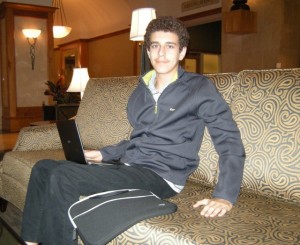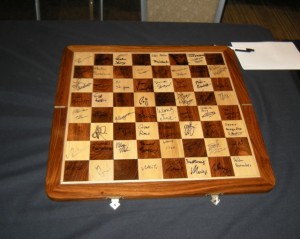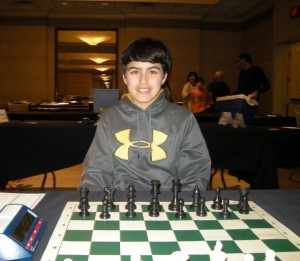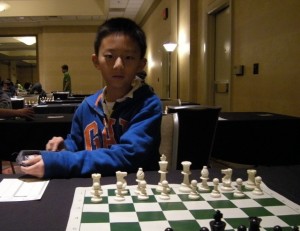The Bay Area International is now in the books, and it ended in a similar way to the North American Open the preceding week: with a huge logjam of people at the top. Six people — grandmasters Anton Kovalyov, Wei Yi, Sam Shankland, Bartlomiej Macieja, Daniel Naroditsky, and international master Darwin Yang — tied for first place at 6½-2½. I was glad, of course, to see the “home-town heroes,” Shankland and Naroditsky, take home some prizes. I was also very happy to see the great result of Darwin Yang, even if he isn’t a local (he comes from Texas). He earned his third grandmaster norm, and so he will soon be GM Darwin Yang.
Here’s a link to a post by Susan Polgar with a great picture of Darwin Yang and Daniel Naroditsky at a very young age. They’ve grown up in a lot of ways, not only in chess stature but in physical stature. Here’s what Daniel looks like now. I took the picture before last night’s round, as he was preparing for his game with Josh Friedel. He was at the tournament site early all of the last three days, the first of the tournament leaders to show up.
 The whole standings have been posted at http://www.sfinternationalchess.org/2014-standings.php if you want to look up how your favorite player did.
The whole standings have been posted at http://www.sfinternationalchess.org/2014-standings.php if you want to look up how your favorite player did.
The pairings for the last round were kind of interesting because the three leaders (Kovalyov, Shankland, and Macieja, with 6 points) had already played each other. So they were paired against three players who had 5½ points (Margvelashvili, Ipatov, and Roiz). Although it’s common to see short draws at the top in the last round of big tournaments, I thought that there was a real possibility of fighting chess here, because the co-leaders couldn’t count on the other co-leaders to draw. Also, their opponents with 5½ definitely needed to win, and so they would hardly be eager to play a short draw.
The top three games were in fact good battles, but nevertheless they all ended in draws, and that gave an opportunity for the other people with 5½ to catch up, and that is what Yi, Naroditsky and Wang did. I didn’t really see how the games went, except that Naroditsky was a pawn down against Friedel. But obviously he found compensation somewhere. I’ll be interested to play over that game when it goes up on the website.
As for my own result, well, for the tournament as a whole it was disappointing but at least the last round ended on a high note. In round eight I played against Cameron Wheeler, and lost as White in a French Defense that looked as if I had never played against the French before in my life.
That wasn’t an accident, because this was only the second time in 30 years (!) that I played 1. e4 e6 2. d4 in a tournament. It’s been that long that I have been fascinated by a side line, 1. e4 e6 2. Nf3 d5 3. Nc3. However, I have recently decided that this two knights’ variation just isn’t good enough to be my main weapon against the French, and so I resolved to go back to the main line. However, I have very little experience with it! This is when I really wish there were still a chess club in Santa Cruz, a place where I could try stuff like this out before going into a tournament game against a kid who has played the French for probably his whole life. Instead, I was out there improvising and it got really ugly, really fast.
The last round was as different from the eighth round as night from day. I was again paired against a young phenom, Michael Wang, whom I have seen many times but never played before.
This time I was Black in what is probably my favorite variation in all of chess, the Bird/Blackburne Variation of the Ruy Lopez, and you could easily see the difference. It was by far my best game of the tournament, completely clean and mistake-free from beginning to end, and you can tell that I knew exactly what I was doing. By the way, I think you would be hard pressed to figure out where Wang went wrong. Obviously he did somewhere, but all of his moves were quite plausible and they were at time ingenious. I was impressed by him even though he lost.
I know you guys want to see the game, but it is definitely a ChessLecture-quality game, and so I’m going to save my detailed comments for there. However, one thing that was really great about it was that I asked the Mike Splane Question: “How am I going to win this game?” There was a critical position at move 28 where I had just won the exchange, but Wang had all sorts of threats and it was very far from clear if I could defend them all. When I asked the Mike Splane Question, my immediate thought was, “Jeez, I don’t know how I’m going to win this game. I’m just trying to survive the next few moves.” But the question got me out of survival mode an into a mode of thinking what needed to happen to get into a winnable position. I decided that two things needed to happen — first, I needed to restrict the mobility of his extra bishop, and second, I needed to trade queens.
When I thought about it that way, I realized that the only variation that accomplished those goals was one that I had already looked at and discarded. In fact, it’s a variation that appears stupid on the surface because it allows him to play his main tactical shot and win a pawn… But in the process, the queens come off, and when the smoke clears I’m in a completely winning endgame.
So, to sum up, I ended up with 3½ points, on 2 wins, 3 draws, and 4 losses. For the second tournament in a row I did really well with the Black pieces (2 wins, 1 draw, 2 losses) but my result with White was unacceptable (2 draws, 2 losses). If only I could play White with the same sense of confidence and savoir-faire that I seem to have (most of the time) as Black!
Even though I fell short of my goal of 4½ points, I think I will gain some rating points, both FIDE and USCF, and that’s a nice little consolation. I can’t emphasize enough what a great experience it was simply to play nine consecutive games against masters. (Wang, with a USCF rating of 2269, was the lowest-rated opponent I played.) Typically I get to play against four or five masters in a year, so nine masters in one week is just an unbelievable opportunity. All in all, I’ll probably play in this tournament again if I have the chance.

The traditional Bay Area International chess board, signed by all the participants. My signature is on d8.




